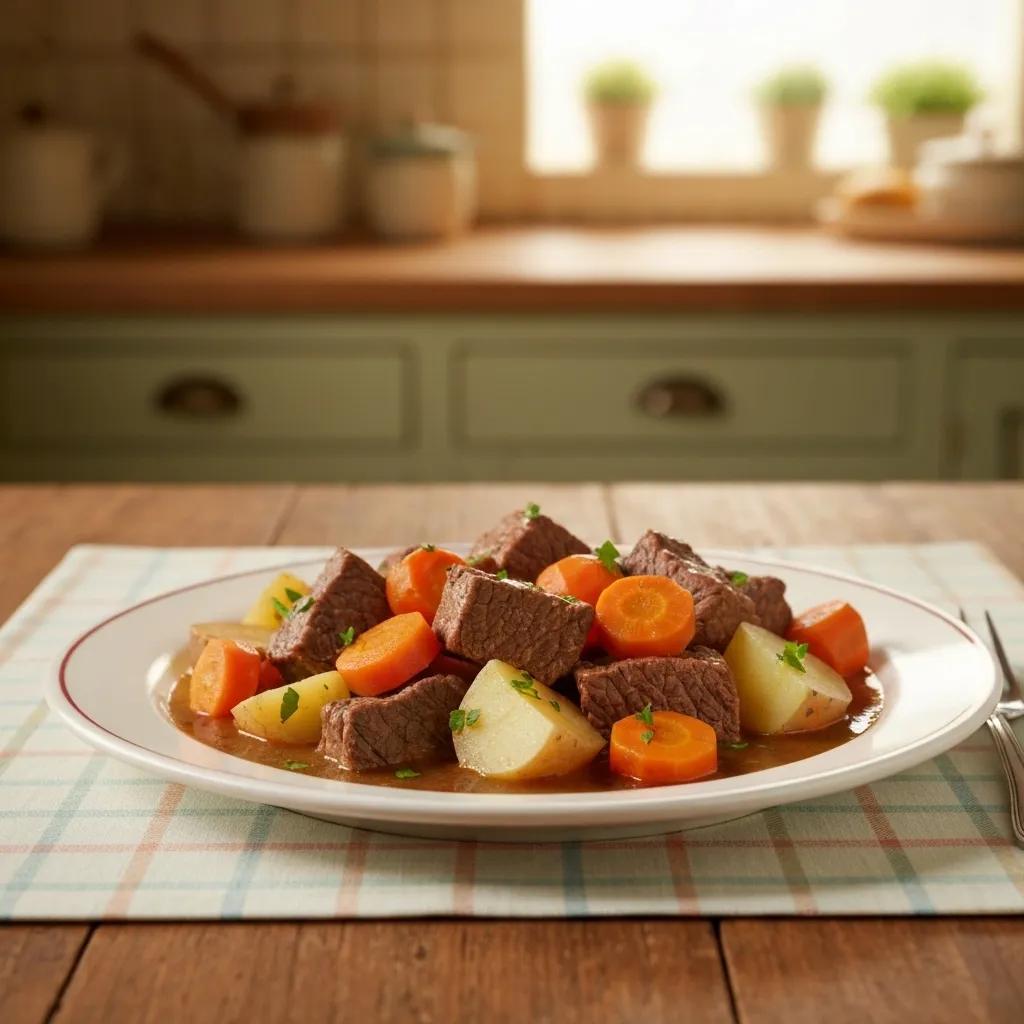Discover the Best Meat for Beef Stew Recipes - Expert Guide

Best Meat for Beef Stew Recipes: How to Choose and Cook Tender, Flavorful Beef Cuts

Selecting the perfect meat for beef stew recipes can transform a simple pot into a rich, comforting masterpiece that captivates every palate. Home cooks often struggle with tough, dry chunks or bland flavor—but choosing the right cut and technique promises melt-in-the-mouth results and a broth brimming with depth. This guide delivers expert insights on the best beef cuts, cooking methods, classic recipes, complementary ingredients, nutrition facts, and online buying tips—while highlighting grass-fed, premium Corriente beef options from Capital Farms. You’ll learn which cuts excel in stew, how to prep and cook them, recipe variations, flavor pairings, health benefits, and seamless ways to order quality beef for your next hearty meal.
What Are the Best Beef Cuts for Stew?
Beef cuts ideal for stew balance collagen-rich connective tissue and marbling, which break down into gelatin during slow cooking to yield tender, flavorful meat. Choosing these cuts ensures a hearty texture and savory depth in every spoonful.
When selecting stew meat, look for:
| Cut | Key Attribute | Stewing Benefit |
|---|---|---|
| Chuck Roast | High collagen | Yields rich, fall-apart strands |
| Short Ribs | Bone-in marrow | Adds depth, velvety mouthfeel |
| Brisket | Moderate marbling | Firm bite that slowly tenderizes |
| Oxtail | Gelatin-rich joints | Creates a silky, unctuous broth |
Why Is Chuck Roast Ideal for Beef Stew?
Chuck roast is a shoulder cut defined by pronounced marbling and connective tissue, which melts into gelatin during braising to support a succulent, flavorful texture. Its balance of fat and collagen ensures each cube breaks down without disintegrating completely, making it the workhorse of stew meat selection.
How Do Short Ribs Enhance Stew Flavor and Texture?
Short ribs combine bone-in richness with abundant intermuscular fat, infusing stew with deep umami and a velvety mouthfeel. As the marrow dissolves, it heightens savory notes and creates a luxurious broth that clings to each tender bite.
What Other Cuts Like Brisket and Oxtail Work Well for Stewing?
Brisket and oxtail serve as excellent stew alternatives when you seek diverse textures. Brisket’s moderate marbling yields a slightly firmer but thoroughly tender result, while oxtail’s high gelatin content produces a glossy, thickened broth and succulent meat around the bones.
How Does Connective Tissue and Marbling Affect Stew Meat Tenderness?
Connective tissue transforms into tender gelatin when exposed to prolonged, gentle heat, whereas marbling distributes intramuscular fat that bastes meat internally. Together, collagen and fat work in concert to maintain moisture, deepen flavor, and support the characteristic “pull-apart” texture of well-prepared stew.
Understanding Collagen Breakdown in Slow Cooking
Collagen, a tough fibrous protein in meat's connective tissues, transforms into gelatin when subjected to low, consistent heat over an extended period, typically around 154°F (68°C). This process is essential for tenderizing tough cuts of meat and enhancing their moisture and succulent texture in dishes like stews.
This research directly supports the article's explanation of how collagen-rich beef cuts become tender and flavorful during slow cooking for stew.
Which Capital Farms Beef Cuts Are Recommended for Stew?
Home chefs seeking premium stew meat turn to Capital Farms for grass-fed Corriente beef cuts tailored to slow cooking. For a classic stew, the 3-lb Chuck Roast delivers balanced fat and collagen, while bone-in Short Ribs elevate richness and mouthfeel. To explore these specialty cuts, visit Buy Premium Grass Fed Beef Online – Capital Farms Meats and choose the perfect blend of tenderness and flavor for your next pot of stew.
How to Prepare and Cook Beef for Tender, Hearty Stew
Preparing stew meat properly begins with searing and ends with low, slow braising to maximize collagen breakdown and flavor development. Each step plays a critical role in producing a moist, deeply flavored stew.
What Are the Best Cooking Techniques for Beef Stew Meat?

Effective techniques include:
- Searing each piece over high heat to develop Maillard-driven flavor.
- Braising in liquid at low oven or stovetop temperatures for even heat penetration.
- Slow cooking in a crockpot to maintain steady warmth and gentle simmer.
- Pressure cooking in an Instant Pot to accelerate collagen breakdown without sacrificing tenderness.
How Does Searing Improve Flavor in Beef Stew?
Searing beef creates a browned crust through Maillard reactions, which generate complex savory compounds and a deep caramelized aroma. This foundational flavor layer infuses the entire stew and enhances richness in the final broth.
The Maillard Reaction and Flavor Development in Cooking
The Maillard reaction is a complex chemical process between amino acids and reducing sugars that occurs at high temperatures, typically above 140°C (280°F). This reaction creates brown pigments and generates hundreds of different flavor compounds, contributing to the distinctive savory aromas and tastes found in seared meats and other browned foods.
This information verifies the scientific basis for searing beef to develop deep, complex flavors in stew, as described in the article.
What Are the Differences Between Slow Cooker, Dutch Oven, and Instant Pot Stew Methods?
For stew preparation, each appliance offers distinct results:
| Method | Key Parameter | Result |
|---|---|---|
| Slow Cooker | Low, steady heat | Hands-off cooking, consistent tenderness |
| Dutch Oven | Stovetop to oven | Crust formation, intensified depth |
| Instant Pot | High-pressure braise | Rapid gelatin conversion, time savings |
How Long Should Beef Stew Cook for Optimal Tenderness?
Aim for:
- 2.5–3 hours at 300°F in a Dutch oven
- 8–10 hours on low in a slow cooker
- 35–45 minutes under high pressure in an Instant Pot
These guidelines allow connective tissues to break down fully, resulting in uniformly tender meat.
What Are Common Troubleshooting Tips for Tough or Dry Stew Meat?
When stew meat turns out chewy or dry:
- Ensure even, high-heat searing before braising to lock in juices.
- Maintain a gentle simmer; avoid rapid boiling that tightens proteins.
- Add a splash of beef broth or wine if liquid evaporates.
- Extend cooking time incrementally until meat yields easily to a fork.
What Are Classic and Easy Homemade Beef Stew Recipes Using Premium Beef?

Classic beef stew combines premium stew cuts, aromatic vegetables, and a savory braising liquid to create a comforting one-pot meal. Using grass-fed Corriente beef enhances each recipe with superior flavor and robust nutrition.
How to Make a Traditional Beef Stew with Chuck Roast?
Begin by seasoning and searing 2 lbs of cubed chuck roast until browned. Remove meat, sauté onions, carrots, and celery, then return beef to the pot. Add 4 cups beef broth, 1 cup red wine, thyme, bay leaf, and simmer covered for 3 hours until meat is fork-tender.
What Is the Best Slow Cooker Beef Stew Recipe?
Layer seared chuck roast cubes, chopped potatoes, carrots, onions, and 2 garlic cloves in a slow cooker. Mix 1/4 cup tomato paste with 4 cups beef stock, pour over ingredients, and cook on low for 8 hours. Finish with cornstarch slurry to thicken the sauce.
How to Prepare Dutch Oven and Instant Pot Beef Stew Recipes?
For a Dutch oven, follow the traditional sear-braise method at 325°F for 3 hours. In an Instant Pot, use the sauté function for searing, then seal and pressure cook on high for 40 minutes before a natural release. Both methods yield succulent stew with minimal supervision.
What Are Popular Variations Like Beef Bourguignon?
Beef Bourguignon elevates stew with pearl onions, mushrooms, and bacon, braised in Burgundy wine rather than broth. The rich reduction and aromatic enhancements deliver a refined twist on classic beef stew.
How to Link Capital Farms Beef Products to These Recipes?
Integrate Capital Farms’ grass-fed chuck roast and short ribs into any stew variation by ordering your stew meat bundle directly from Buy Premium Grass Fed Beef Online – Capital Farms Meats. Quality ingredients from a trusted source ensure consistent, restaurant-level results at home.
Which Ingredients and Flavor Profiles Complement Beef Stew Meat?
Balancing vegetables, liquids, herbs, and umami boosters creates complexity in beef stew. The right combination elevates each bite and supports meat-driven richness.
What Vegetables Are Essential for a Hearty Beef Stew?
A classic mirepoix of carrots, onions, and celery provides aromatic depth, while potatoes add body and absorb savory juices. Garlic and parsnips can also expand earthy undertones.
How Do Broth and Liquid Choices Affect Stew Flavor?
Pure beef broth emphasizes meat-forward savor, while stock adds subtle fat and collagen. Red wine contributes acidity and fruit notes, and a splash of tomato paste deepens color and umami.
What Herbs and Spices Enhance Beef Stew Taste?
Thyme and bay leaf impart herbal warmth, cracked black pepper adds bite, and Worcestershire sauce reinforces savory umami. Rosemary or parsley can be added at the finish for a fresh herbal lift.
How to Thicken Beef Stew Properly?
A smooth paste of flour or cornstarch mixed with cold water creates a glossy, clingy sauce. Gluten-free alternatives like arrowroot or tapioca starch offer clear results without cloudiness.
How Does Umami Influence Beef Stew Flavor?
Natural glutamates in beef, mushrooms, and tomato paste intensify savory perception and enrich broth complexity. Layering umami-rich ingredients amplifies depth without overwhelming other flavors.
What Is the Nutritional Value and Health Benefits of Beef Stew Made with Premium Cuts?
Beef stew delivers a balanced meal with high-quality protein, essential vitamins, and minerals—especially when using grass-fed Corriente beef rich in omega-3s and antioxidants.
What Is the Calorie and Macronutrient Breakdown of Beef Stew?
| Nutrient | Amount per 1-cup Serving | Role |
|---|---|---|
| Protein | 25 g | Supports muscle repair |
| Fat | 15 g | Provides satiety and energy |
| Carbohydrate | 20 g | Fuels activity and flavor |
Which Vitamins and Minerals Are Present in Beef Stew?
Beef stew offers iron for red blood cell formation, zinc for immune support, and B vitamins (B12, niacin, riboflavin) for energy metabolism and neurological health.
How to Make a Healthier Beef Stew Without Sacrificing Flavor?
Substitute lean brisket or trimmed chuck roast, increase the ratio of vegetables, and reduce added fats. Use low-sodium broth and add herbs for flavor, achieving a nutrient-dense stew without compromising richness.
Why Choose Grass-Fed Corriente Beef for Health and Sustainability?
Grass-fed Corriente beef from Capital Farms contains higher omega-3 content, conjugated linoleic acid, and antioxidants compared to grain-fed meat. Sustainable grazing practices support animal welfare and environmental stewardship, delivering a premium product you can trust for both health and flavor.
Nutritional Benefits of Grass-Fed Beef
Research indicates that 100% pasture-fed beef can be recognized as a source of long-chain omega-3 fatty acids, containing over 40mg per 100g of meat. Studies show that grass-fed beef has a more favorable omega-6 to omega-3 fatty acid ratio and higher levels of beneficial omega-3s (EPA, DPA, DHA) compared to grain-fed beef, offering potential health benefits such as anti-inflammatory properties.
This research supports the article's claims regarding the superior nutritional value of grass-fed beef, particularly its higher omega-3 content and health implications.
What Are Expert Tips for Selecting and Buying Beef for Stew Online?
Online ordering requires clear criteria for cut selection, quality assessment, and safe handling to ensure optimal stew results.
How to Choose the Right Beef Cut Based on Flavor, Tenderness, and Budget?
Evaluate collagen content for tenderness, marbling for richness, and price per pound. Chuck roast offers affordability and balance, short ribs deliver luxury at a higher cost, and brisket or oxtail serve niche preferences for texture and broth body.
What Are the Benefits of Buying Grass-Fed, Grass-Finished Beef from Capital Farms?
Purchasing from Capital Farms guarantees premium Corriente beef raised on open pastures without antibiotics or added hormones. Grass-finished practices enhance nutrient profiles and deliver consistent quality, making it an excellent choice for stew enthusiasts.
How Does Convenient Online Ordering and Delivery Work for Stew Meat?
Capital Farms’ e-commerce platform allows you to select specific cuts or curated bundles, choose delivery dates, and receive vacuum-sealed packages at home. This streamlined process ensures freshness and maintains cold-chain integrity from farm to table.
How to Store and Handle Beef Cuts Before Cooking?
Keep fresh stew meat refrigerated at 32–40°F and use within 3–5 days. For longer storage, freeze in airtight packaging and thaw slowly in the refrigerator. Proper handling preserves texture and flavor when you’re ready to cook.
What Are Frequently Asked Questions About Meat for Beef Stew Recipes?
Many cooks ask which cut works best, how to achieve tender results, which vegetables to include, how to thicken the sauce, and how long to cook stew. The top choices are chuck roast and short ribs for their collagen and marbling. Tenderness depends on low, slow heat and proper searing. Carrots, potatoes, onions, and celery form the classic vegetable base. To thicken, whisk flour or cornstarch into cold water before stirring into a simmering pot. Cooking time ranges from 2.5 hours in a Dutch oven to 8 hours on low in a slow cooker or about 40 minutes under pressure in an Instant Pot.
Steer clear of high-heat boiling and extend cooking time if needed; adjusting liquid levels and adding gentle thickening agents ensures a rich, velvety consistency without dryness.
Bringing together the right cut, cooking technique, and complementary ingredients transforms beef stew into a signature dish. By choosing grass-fed Corriente beef from Capital Farms, you secure premium meat designed to deliver exceptional tenderness and flavor. With these insights, you’re equipped to master every step—from cut selection and braising methods to recipe variations and nutrition optimization. Explore Capital Farms’ selection today to elevate your next beef stew into a truly unforgettable experience.
